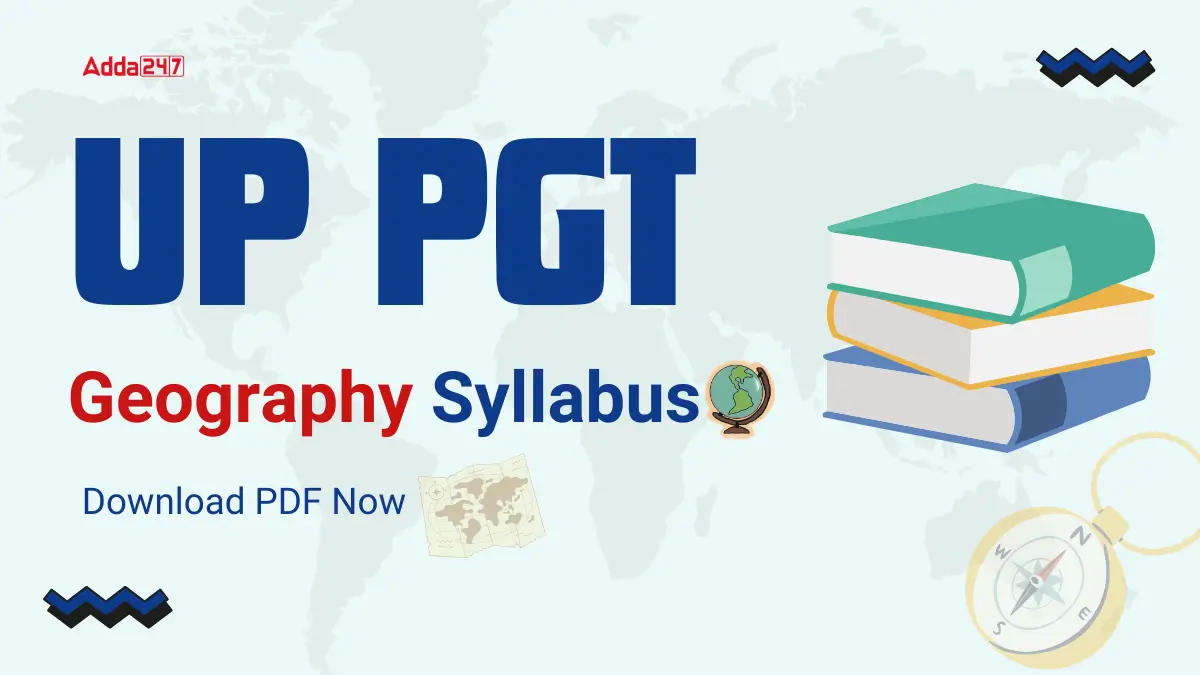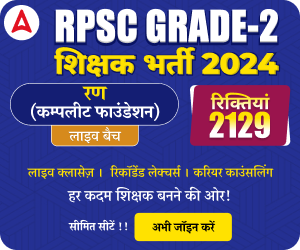Table of Contents
UP PGT Geography Syllabus 2025 has been released by the Uttar Pradesh Secondary Education Services Selection Board (UPSESSB) on their official website. Candidates are encouraged to go through the PGT Geography Syllabus prescribed by the UPSESSB for the UP PGT post. This will provide them indepth knowledge about the extent of the syllabus, nuances of exam pattern, marks distribution, marking scheme and details. For more information on the UP Post Graduate Teacher Geography Syllabus 2025, candidates are advised to check out the following article thoroughly.
UP PGT Geography Syllabus 2025
Aspirants preparing for the UP PGT Geography Exam 2025 must thoroughly understand the syllabus, exam pattern, and marking scheme to strategize their preparation effectively. The syllabus covers essential topics like Physical Geography, Human Geography, Economic Geography, and Regional Geography, including key concepts, landforms, climate, resources, and India’s geographical aspects.
The UP PGT Geography exam pattern consists of 125 MCQs, totaling 425 marks, with no negative marking and a 2-hour duration. The marking scheme awards 3.4 marks per question, while the marks distribution for PGT candidates includes a written exam (425 marks – 85%), an interview (50 marks – 10%), and special qualifications (25 marks – 5%), making a total of 500 marks. A detailed understanding of these aspects helps aspirants focus on high-scoring topics, manage time efficiently, and improve their chances of success.
UP PGT Geography Syllabus 2025: Overview
The UP PGT Geography Syllabus 2025 has been released by the Uttar Pradesh Secondary Education Service Selection Board (UPSESSB) for the recruitment of 624 PGT Teacher vacancies. The selection process includes a written exam and additional weightage based on qualifications and interviews. The UP PGT Geography exam is scheduled to be conducted on 20th and 21st June 2025.
spirants must thoroughly study topics like Physical Geography, Human Geography, Economic Geography, and Regional Geography, covering aspects such as Earth’s structure, climate, natural resources, population dynamics, industrial patterns, and India’s geographical features. A clear understanding of the syllabus will help candidates prepare strategically and enhance their chances of success in the examination.
| UP Geography PGT Syllabus 2025 | |
| Origination Name | Uttar Pradesh Secondary Education Service Selection Board |
| Name of Post | UP PGT Teachers |
| No. of PGT Vacancy | 624 Vacancies |
| Selection Process | Written Exam, Weightage |
| Category | Uttar Pradesh Teacher Syllabus |
| Exam Date for PGT | 20 June-21 June 2025 |
UP PGT Geography Exam Pattern 2025
The UP PGT Geography Exam Pattern 2025 consists of 125 multiple-choice questions (MCQs), with a total of 425 marks. Each question carries 3.4 marks, and there is no negative marking for incorrect answers. Candidates are given a 2-hour time duration to complete the exam. This pattern ensures a fair assessment of candidates’ knowledge and expertise in geography while allowing them to attempt all questions without the fear of losing marks for incorrect responses.
| UP PGT Geography Exam Pattern 2025 | |
| No. of Questions | 125 Questions |
| Time Duration | 2 hours |
| Marks | 425 |
| Negative Marking | No |
| Each Question | 3.4 marks |
| Type of Questions | MCQ |
UP PGT Geography Marks Distribution 2025
The UP PGT Geography Marks Weightage 2025 outlines the selection criteria for candidates. The written exam holds the highest weightage, carrying 425 marks (85%), making it the most crucial component of the selection process. Additionally, candidates will be evaluated through an interview, which accounts for 50 marks (10%), assessing their subject knowledge, teaching aptitude, and communication skills.
Lastly, special qualifications such as higher academic achievements or relevant certifications contribute 25 marks (5%), providing an added advantage to eligible candidates. The total marks for the selection process sum up to 500, making it essential for aspirants to perform well in all three components to secure a strong position in the merit list.
| UP PGT Geography Marks Weightage 2025 | |||
| S.No. | Exam | Marks | Percentage |
| 1 | Written Exam | 425 | 85 |
| 2 | Interview | 50 | 10 |
| 3 | Special Qualification | 25 | 5 |
| Total | 500 | 100 | |
UP PGT Geography Syllabus In Detailed
The UP PGT Geography Syllabus covers a wide range of topics, including Physical Geography, Human Geography, Economic Geography, and Regional Geography. It includes key concepts such as determinism, possibilism, and environmental determinism, along with contributions from notable geographers. The syllabus explores Earth’s structure, climate, hydrosphere, biosphere, and natural resources, focusing on landforms, ocean currents, vegetation, and biodiversity conservation.
It also delves into population growth, agricultural patterns, industrial development, and international trade. Additionally, the syllabus provides an in-depth study of India’s geographical features, natural resources, and economic aspects, making it a comprehensive guide for aspirants preparing for the UP PGT Geography exam.
| UP PGT Geography Syllabus | |
| Unit | Description |
| Definition and Scope of Geography |
|
| Physical Geography- Lithosphere |
|
| Physical Geography- Atmosphere |
|
| Physical Geography- Hydrosphere |
|
| Physical Geography- Biosphere |
|
| Human Geography |
|
| Economic Geography |
|
| Regional Geography |
|
| Natural Aspects of India |
|
| Resource Base | Mineral and energy resources, irrigation, hydroelectric power, multipurpose projects. |
| Economic Aspects |
|
| Population and Economic Development |
|
UP PGT Geography Syllabus 2025 PDF
Candidates can use the table below to download the UP PGT Geography Syllabus PDF. Reviewing the syllabus before starting their preparation will provide clarity on key topics and help them organize their study plan effectively. Consistently referring to the syllabus throughout their preparation will keep them on track and allow them to refine their strategy for improved performance in exams.
| UP PGT Geography Syllabus PDF | |
| UP PGT Geography Syllabus 2025 | Download PDF Now |
| UP TGT PGT 2025 Important Links | |
| UP TGT PGT Notification 2025 | UP TGT PGT Syllabus 2025 |
| UP TGT PGT Previous Year Question Papers | UP TGT PGT Eligibility Criteria 2025 |




 KARTET Syllabus 2025 and Exam Pattern Fo...
KARTET Syllabus 2025 and Exam Pattern Fo...
 KVS PGT Physics Syllabus 2025 and Exam P...
KVS PGT Physics Syllabus 2025 and Exam P...
 KVS PGT Mathematics Syllabus 2025 and Ex...
KVS PGT Mathematics Syllabus 2025 and Ex...














